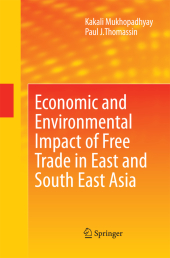 Neuerscheinungen 2014Stand: 2020-02-01 |
Schnellsuche
ISBN/Stichwort/Autor
|
Herderstraße 10
10625 Berlin
Tel.: 030 315 714 16
Fax 030 315 714 14
info@buchspektrum.de |

Kakali Mukhopadhyay, Paul J. Thomassin
(Beteiligte)
Economic and Environmental Impact of Free Trade in East and South East Asia
2010. 2014. xix, 209 S. 235 mm
Verlag/Jahr: SPRINGER NETHERLANDS; SPRINGER 2014
ISBN: 9400791127 (9400791127)
Neue ISBN: 978-9400791121 (9789400791121)
Preis und Lieferzeit: Bitte klicken
This comprehensive analysis offers a perspective on the economic and environmental impacts of regional economic integration in East and South East Asia. A global economic model is used to explore some of the fastest growing economies in the world.
In recent years, the East and South East Asian region has witnessed a rapid expansion of regional economic cooperation through bilateral and plurilateral free trade agreements. The current book attempts to comprehensively analyze the economic and environmental impacts of regional economic integration in East and South East Asia to the year 2020. This region has some of the fastest growing economies of the world. A global economic model was used to undertake the analysis. A rare feature of the book is the detailed environmental implications of the Regional Trade Agreements focusing on air, water, and waste pollution. Economic integration among the East and South East Asian region has been an important agenda item for the academic and policy communities in recent years.
The study provides insight into pursuing a concrete multilateral trade liberalization policy (combining ASEAN and other countries in East Asia) and throws more light on the on-going trade and environment debate. This book will be a good addition to the field of trade and the environment. The academic community - primarily researchers and policy makers, and world bodies, such as the WTO, ADB and the World Bank, will benefit from the book.
Preface.- Acknowledgements.- List of Tables.- List of Figures.- 1 Introduction.- 1.1. Globalization and Regionalization.- 1.2. Basic Issues of Regional Trade Agreements.- 1.3. Proliferation of Regional Trade Agreements.- 1.4. Global Development of RTAs.- 1.5. Economic Integration in East and South East Asia.- 1.6. Environmental Degradation.- 1.7. Objective.- 1.8. Structure of the Book.- 2 Review of Literature.- 2.1 Introduction.- 2.2 FTAs /RTAs around the World.- 2.3 FTAs /RTAs in East and South East Asian Region.- 2.4 Impact of FTAs and RTAs on the Environment.- 3 Features of the East and South East Asian Economies.- 3.1. Introduction. - 3.2. Population.- 3.3 Economic Growth of the East and Southeast Asian Economies.- 3.4 Poverty and Unemployment.- 3.5 The Structure of Foreign Trade and FDI.- 3.6. Environmental Profile: An Overview.- 4 Theoretical Framework, Database, and Scenario Development.- 4.1. The Theoretical Framework of the GTAP Model.- 4.2 Aggregation Scheme.- 4.3 Environmental Indicators and Coefficients.- 4.4 Updated Environmental Coefficients across the Countries.- 4.5 Scenario Development.- 4.6 Modifications of the GTAP Model to 2020.- 4.7 Macroeconomic Variable Estimates and Underlying Assumptions.- 5 Economic Impact of Economic Integration.- 5.1 Introduction.- 5.2 Output Growth.- 5.3 Export and Import Performance.- 5.4 Sectoral Analysis of Output.- 5.5 Sectoral Analysis of Export and Import.- 5.6 Intra-Industry Trade.- 5.7 Welfare Implication.- 5.8 The Effects on Factor Returns.- 5.9 Poverty Implications.- 6 Environmental Impact of Economic Integration.- 6.1 Introduction.- 6.2 Environmental Impact in BAU and Trade Scenarios.- 6.3 Sectoral Analysis in BAU and Trade Scenarios.- 6.4 Decomposition Analysis.- 7 Strategies for Green Trade.- 7.1 Introduction.- 7.2 Multiple Sector Tax.- 7.3 Tax on Electricity.- 7.4 Tax on Coal and Oil.- 8 Summary and Conclusion.- Endnotes.- References.- Annex


